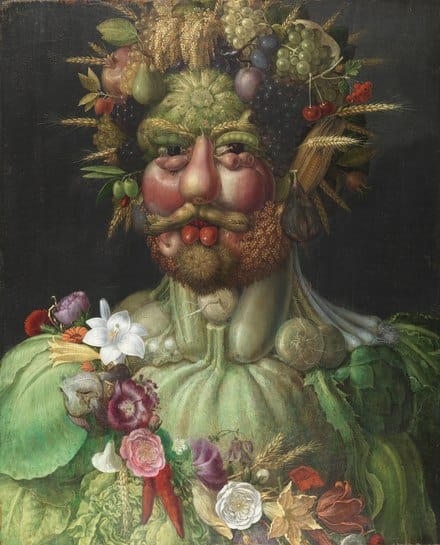Neurodiversity can be an adventure in itself. Your spiritual journey is a deeply personal exploration, and for many neurodivergent people, art can become an intuitive guide in this exploration. I discovered that creativity could become a sacred space for self-discovery, connection, and profound spiritual transformation for me. And I believe that it may be for you also.
We neurodivergent people navigate a world with our unique perceptions and experiences. My journey is likely different from yours. But our uniqueness can bring a distinct and often deeply enriching perspective. Understanding neurodivergence is the first step to appreciating the nuanced role that art can play in our spiritual journeys.

National Gallery of Art, Washington, DC
Arcimbaldo was thought to be neurodivergent. His work is an excellent example of
neurodiversity and creativity .
1. Art is a Spiritual Language:
For many of us, communication can be an intricate dance where we often don’t hear the music and feel like we have two left feet. Art can serve as a universal language that transcends traditional barriers. The awkwardness and hesitancy that I might feel when facing the prospect of having a conversation with another living human being could be daunting. Through the strokes of a brush or the malleability of clay, it was easier for my spiritual experiences to find expression. Art became a medium for translating the ineffable into tangible forms, fostering a deeper connection with my spiritual self.
2. Sensory Exploration can help engage Mindfulness:
The sensory experiences that define neurodivergence are not necessarily obstacles but can be gateways to spiritual exploration. Engaging in art provides a sensory-rich experience, from the tactile sensations of creating to the visual feast of colors and shapes. This sensory engagement becomes a form of mindfulness, a grounding practice that can nurture spiritual growth.
3. Symbolism Allows us to create a Personal Mythology:
Art can allow us to craft our own symbolic language and personal mythology. In the exploration of symbols and metaphors, we can navigate and make sense of our spiritual experiences. Art can reflect our inner landscape, allowing for the creation of a narrative that resonates with our spiritual truths.
4. Art is a Meditative Practice:
As neurodivergent people, we often find solace and introspection in repetitive or rhythmic activities. Art, whether it’s drawing, painting, or sculpting, can become a meditative practice. This meditative state can open a gateway to spiritual insights, offering a quiet space for reflection, connection, and the exploration of one’s inner spiritual landscape.
5. Change Happens When You Embrace the Unconventional:
In the intersection of neurodivergence and spirituality, unconventional paths are not just accepted but celebrated. Artistic expressions that diverge from mainstream norms become portals to unconventional spiritual realms. The acceptance of uniqueness, both in neurodivergent experiences and artistic creations, fosters a spirit of exploration and open-mindedness on the spiritual journey.
6. Art is a Catalyst for Transformation:
Art has the power to catalyze profound transformations. The act of creation can become a transformative journey in itself. The metamorphosis of raw materials into a work of art mirrors the transformative processes of spiritual growth, providing a tangible representation of our evolution on our spiritual path.

7. Spiritual Communities Can Be Built Through Art:
Art can become a bridge that connects us with other like-minded souls on similar spiritual journeys. Shared artistic expressions create a sense of community, creating a space where experiences are understood, shared, and celebrated. This communal aspect of art becomes a foundation for building spiritual connections within our communities.
As we explore the role of art in spirituality from our neurodivergent perspectives, we uncover a spectrum of rich colors and unique patterns. In expressing our creativity, we find a means of expression and a sacred space for spiritual exploration. Let art become a guiding light, offering solace, connection, and transformation on your spiritual growth’s intricate and beautiful journey.
Need Some Help Getting it All Together? Art, Magick & Neurodiversity!
That’s my job. I’m Kymba, a creativity coach for people who are neurodiverse/on the spectrum/have ADHD, etc. I help you get past your block, and teach you how to make your wonderfully imperfect art with the constraints imposed by your alternative neuro-operating system, aging/changing body, or demands of your job, space, or caregiving. I teach people how to steal away the minutes that they need to start or maintain a daily artistic practice. And I’m an artist on the spectrum.